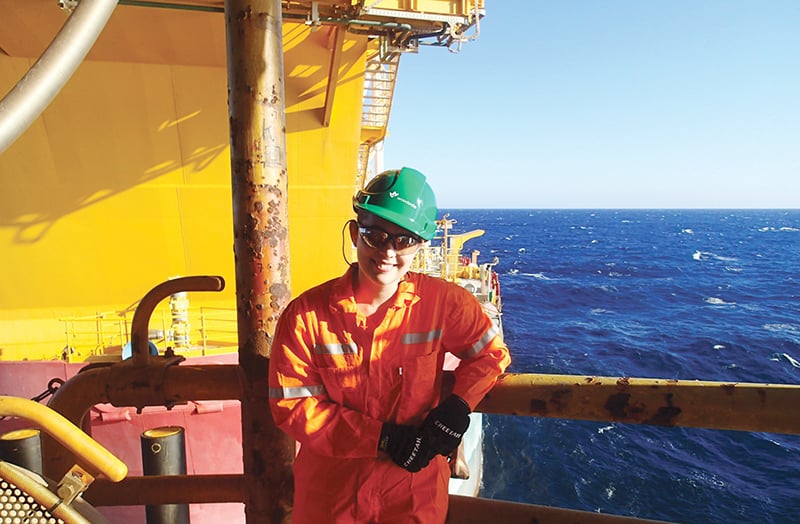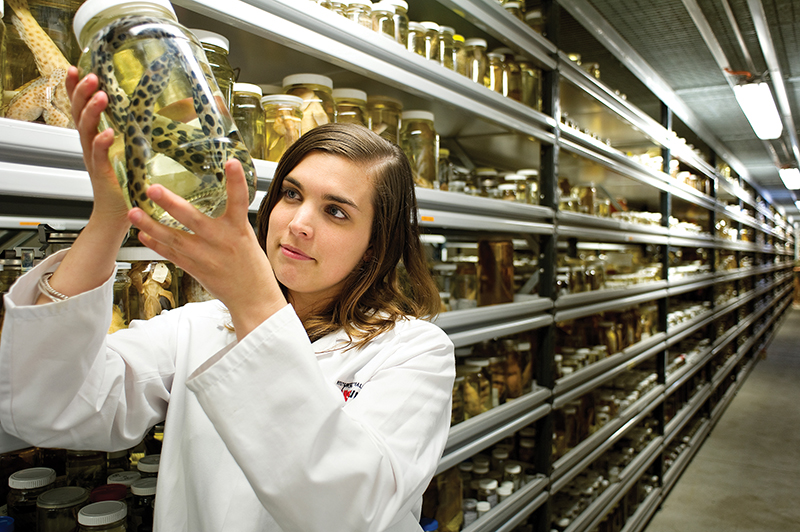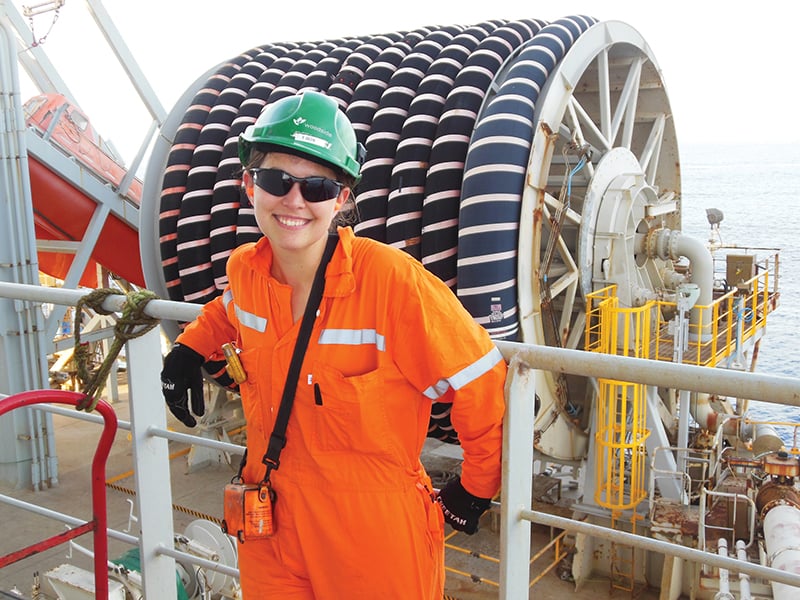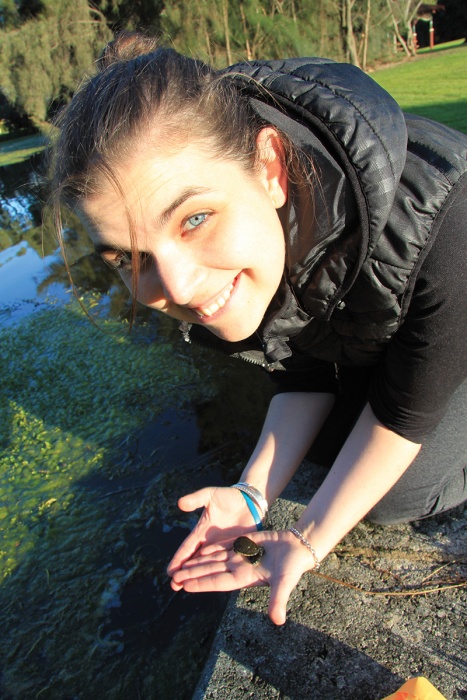Woodside Energy
Tegan Box
From studying turtles and global warming to delivering environmental approvals for offshore geotechnical operations and implementing environmental monitoring surveys for Pluto LNG’s project dredging program, Tegan Box is experiencing a varied life in our environment function.
Tegan, an environmental adviser for offshore oil and gas production facilities, is a qualified marine biologist.
“I’ve always loved the ocean,” she says, “and I spent much of my childhood growing up in Dampier and exploring the islands and reefs of the Dampier Peninsular.”
After graduating with an honours degree in zoology at the University of Western Australia, she joined Woodside in 2007. Since then, Tegan has worked in a variety of roles before her present position, which she started in November 2013.
“I enjoy going on-site and speaking with the teams,” she says. “I like to both understand their issues and also provide advice on how we can drive improved environmental performance.”
Because of the wide variety of Woodsiders and external stakeholders with whom she interacts — from colleagues in the environment function to operators and regulators outside the company — she regularly faces a cross-section of views and opinions.
“I love the challenge of understanding what motivates them, and working together to achieve the best environmental outcome,” she says.
Tegan is also one of the company’s assigned Invasive Marine Species (IMS) focal points. In this role, she proactively manages changing regulatory requirements, education and facilitation of engagement between key Woodside stakeholders.
She also maintains compliance against Woodside’s IMS management plans and procedures and more recently has helped develop Woodside’s international approach to management of marine biofouling.
Here we follow a day in Tegan’s working life…
7.00 AM
Once a fortnight my day starts with an early morning phone hook-up with the health, safety and environment coordinators (HSECs) on our seven manned offshore assets. These hook-ups typically last 60 minutes. We discuss HSE issues and share learnings across the business. The focus is on understanding how we can continue to improve HSE performance across the assets so it ultimately flows on across the business.

9.00 AM
I present an Offshore Production Environmental Leadership Training Session with several of our offshore supervisors. These sessions are not only a great way to meet our offshore supervisors, but also to increase awareness around key environmental risks, including flaring and fuel gas use, spill risks, produced water management and waste segregation.
11.00 AM
I run an IMS Species Risk Assessment for a support vessel which is coming on hire. These risk assessments ensure all vessels used by Woodside present an acceptably low risk of translocating marine pests from our operations.
Marine pests are organisms that have been introduced into a region beyond their natural range where they have the ability to survive and out-compete the native species. Once established they can have significant social, economic and environmental impacts. We are currently developing an international approach to management of marine biofouling as Woodside starts to expand its exploration and operations activities globally.

12.00 PM
I meet with the National Offshore Petroleum Safety and Environmental Management Authority (NOPSEMA) to discuss the outcomes of a recent asset environmental inspection. These are undertaken to verify compliance with the facility’s environment plans. We aim to share learnings from these inspections across all of our assets, and they provide a good drive for continuous improvement.
1.00 PM
After lunch, I phone Tom Clippingdale on the Nganhurra floating production storage and offloading facility (FPSO). Tom’s the offshore installation manager (OIM) and we need to discuss the forthcoming internal environmental inspection of the Nganhurra.
All of Woodside’s offshore assets are subject to annual environmental inspections by the production environment team to verify compliance with the facilities’ environment plan. I find these inspections are a great opportunity to familiarise myself with our offshore assets and communicate learnings from other assets – and, of course, they provide the chance for a little marine fauna observation. Depending on the time of year, we can spot humpback whales on their annual migrations up and down WA’s coast.

2.00 PM
I pay a visit to Dawn Forsyth, an environment adviser within the Development team, to discuss upcoming Greater Western Flank Phase 1 (GWF-1) activity and the interface with the GWA asset. GWF-1 Project involves the drilling and completion of wells that will be tied back to the Goodwyn A Platform via a subsea production system.
4.00 PM
Time to catch up with Denise McCorry from the central environmental studies team to discuss the scope of a sediment and water quality study at another FPSO, the Northern Endeavour, to verify results of produced water discharge plume studies.
Environmental field monitoring at our production assets is a big focus as we need to ensure the impacts are controlled to As Low As Reasonably Practicable (ALARP) levels.

6.00 PM
I get home from work around 6pm and I often spend my evenings walking around my local freshwater lakes. These walks allow me to slow down and reflect on the day, but they also allow me to help in the protection of our local native fauna.
In my spare time I support the Turtle Oblonga Rescue and Rehabilitation Network (TORRN) which rescues and rehabilitates sick and injured Oblong turtles. I use these walks as an opportunity to monitor for oblong turtles around these lakes.

Monitoring is particularly important between October and December as this is when the females undertake their migrations between lakes and nesting sites. This journey often takes them across roads and sometimes they need a little bit of help to make it safely.
I think that’s also very true of my role at Woodside, which is about helping and supporting the business to minimise impacts to the environment. I’m fortunate to be able to work for a company that considers the environment as an important part of its decisions.
Thinking of experiencing life as a Woodside Energy Graduate? Sign up with Prosple to receive job alerts for Woodside Energy.